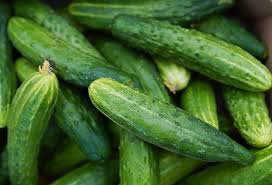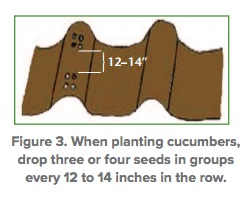“A pleasant evenin’, though warm, which, bless you, Mr. Chuzzlewit, we must expect when cow cumbers is three for tuppence.” — Sairey Gamp


FAST FACTS
Benefits and nutritional information:
- Cucumbers are high in nutrients but low in calories. They contain antioxidants, may help lower blood sugar, and promote hydration. They are especially high in Vitamin K (57% of DV), Vitamin C (10%) and Magnesium (9%)
Starting:
- Cucumbers may be started from seeds or from starts. They will generally mature in 55 to 70 days.
When to plant:
- If seeding directly into the garden you must wait until the soil temperature has warmed to at least 60 degrees. The seeds will not germinate below that temperature.
- Mature plants should be from 18 to 36 inches apart. It’s best to sow several seeds about an inch into the soil in each location where you’ll want a plant to grow.
- If growing your own starts, they should be planted indoors 3 to 6 weeks before you plan to transplant them into the garden.
- Starts planted indoors do especially well when given bottom heat of about 70 degrees (21C).
- Prior to planting them in the garden they should have at least 3 to 4 true leaves, and the plants should have been hardened off.


Thinning, training
- Cucumber plants should be spaced from 18 to 36 inches apart — closer if they’re to be grown on a trellis; further apart if they’re to be left to grow along the ground.
- It’s important to remember that vining cucumbers (compared to bush style cucumbers) grown on a trellis tend to be less susceptible to insect and disease pests than those grown in contact with the soil — most importantly garden slugs and powdery mildew.
Signs of over-watering, nutrient deficiency
- Cucumbers need only moderate amounts of nitrogen but higher levels of phosphorous and potassium. An organic fertilizer with — for example - a ratio of 3-4-6 is recommended.
- Some growers add coffee grounds to the soil since it both adds essential nutrients and discourages slugs.
- Leaf yellowing and root rot are two of the most notable features of cucumbers that are overwatered.
Pests and pest controls
- Cutworms. Your young cucumber plants are coming along nicely; four or five nice leaves branching out on top of the shoots. But the next morning you check on them and all you see is a very short stub that looks like it was chewed off. Suspect cutworms first.
- Slugs and snails. These will also eat young shoots but will also leave areas on maturing fruit where they’ve scraped off the skin and left exposed patches of the inside.
- Powdery mildew. Looking like fuzzy white patches on the leaves, mildew can quickly devastate an entire vine. If not treated promptly, mildew will go on to destroy an entire crop of your cucumbers, squash (including zucchini) and tomatoes, plus those of your neighbors.
- Flea beetles. Leaves that have a lot of small holes — similar to being peppered by a shotgun — have usually been attacked by flea beetles.
- Others such as aphids, cabbage loopers, whiteflies.
Harvesting
- Cucumber harvesting isn’t an exact science. Many cucumbers are eaten when immature. However, cucumbers are generally ripe and ready for harvest anywhere from 50 to 70 days after planting. A cucumber is normally considered ripe when it is bright medium to dark green and firm.
- Some sources recommend leaving a 1” portion of stem attached to the cucumber when harvesting.
- When cucumbers begin to turn yellow or develop wrinkled tips they are beyond ripe and should be discarded promptly.
